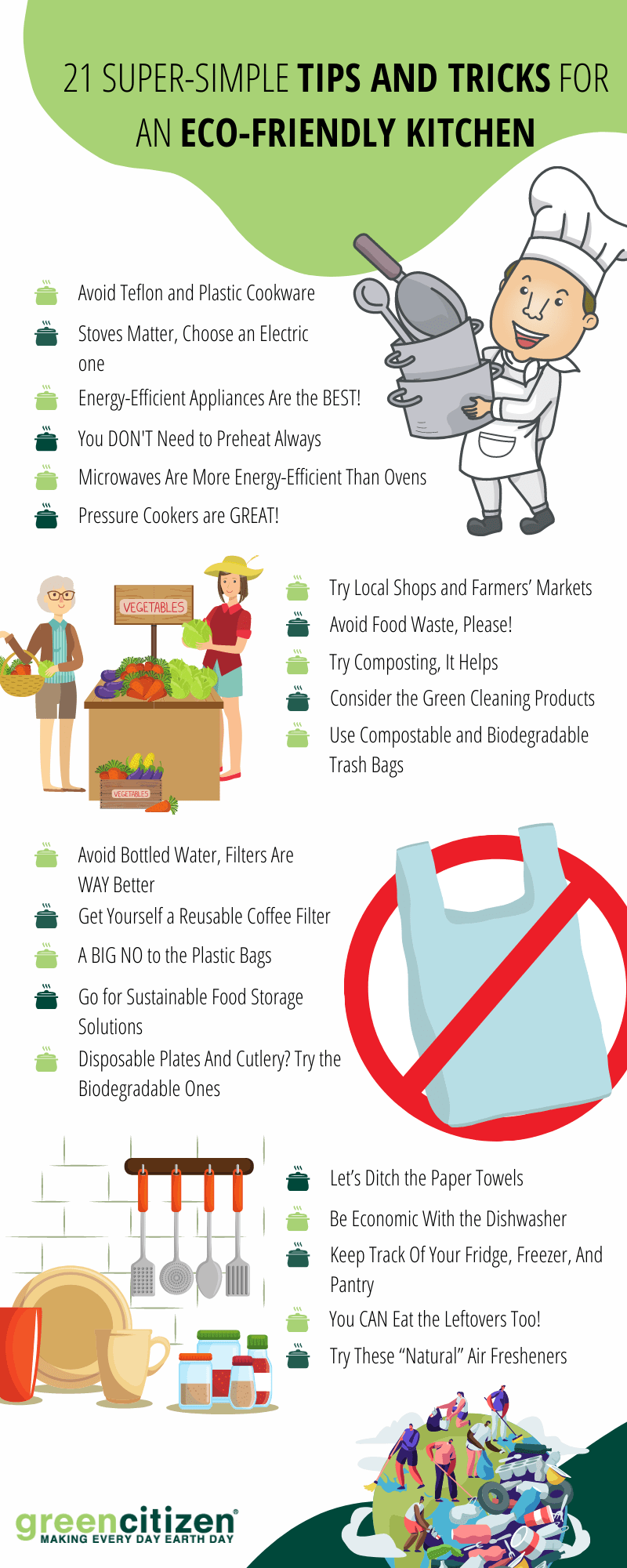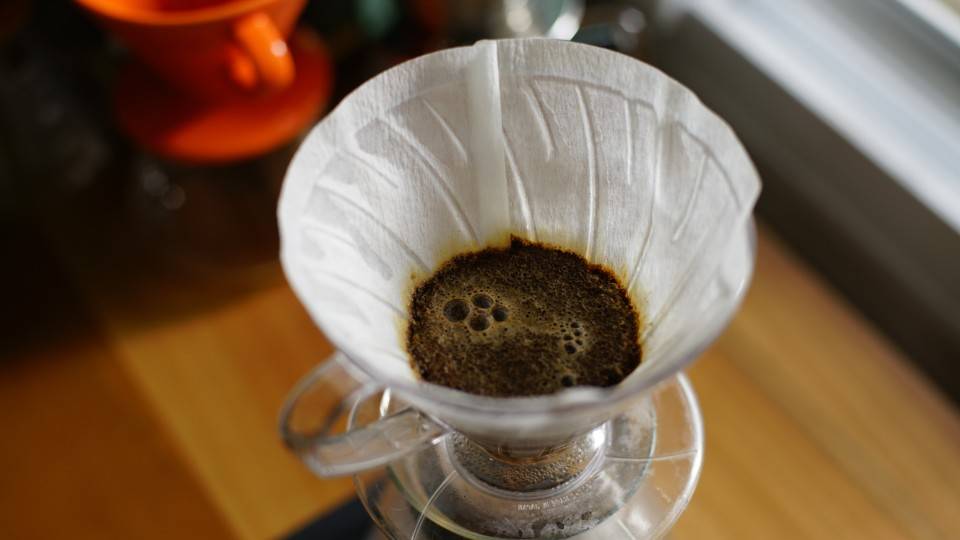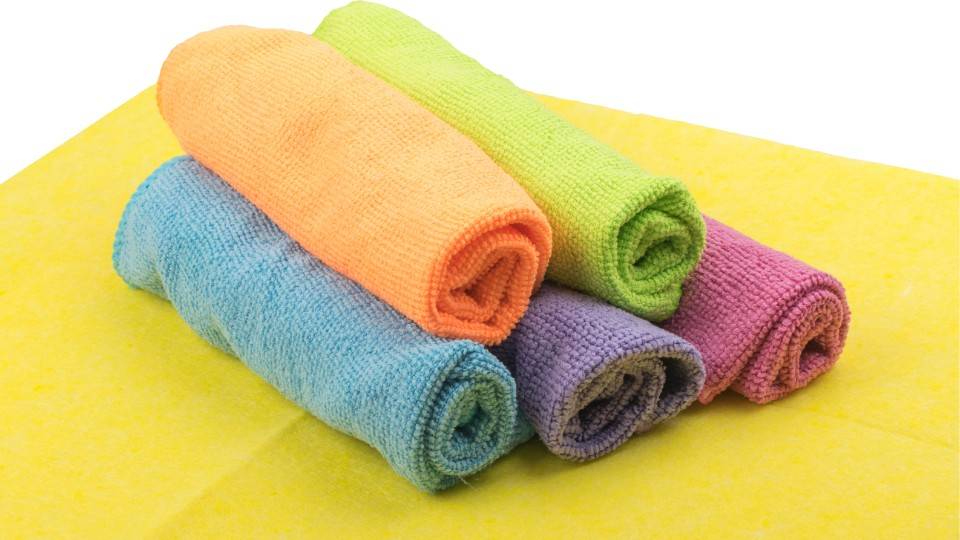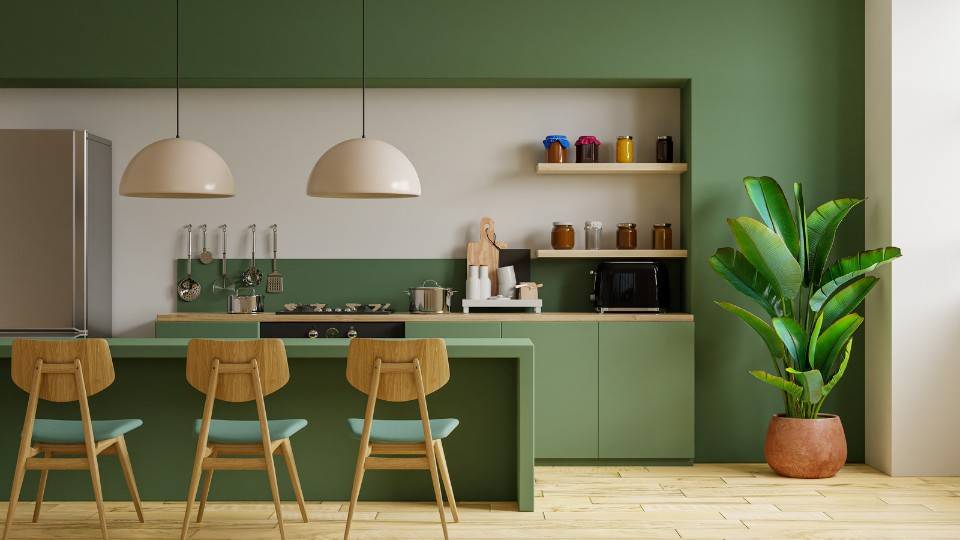The kitchen produces the most waste out of all the rooms in your home. Think about all the expired food, plastic, and paper you throw out weekly.
I’ll admit, I didn’t pay much attention to my kitchen either. But, in the last year, as I was forced to spend more time home and more time cooking, I became aware of all the waste my kitchen is creating.
So, I decided to do something about it. I did make an effort to eat green, but that wasn’t enough. I soon discovered many ways to have an eco-friendly kitchen — from energy-efficient food preparation to using the right kind of equipment and avoiding toxic chemicals.
Today, I’ll share all my tips on how I transformed my kitchen so you too can have a healthy kitchen full of sustainable products (and you’ll save some money as well).
21 Super-Simple Tips and Tricks for an Eco-Friendly Kitchen

Avoid Teflon and Plastic Cookware
If you’ve been doing more cooking like me, it’s time to consider the pots and pans and cookware you’re using.
Yes, we all love Teflon because of its non-stick properties. But, Teflon has also become known for all the toxic chemicals it releases. Moreover, Teflon is easily damaged and has to be replaced often, which leads to expenses.
It’s time to ditch the Teflon.
Instead, choose stainless steel or cast-iron cookware. This will last for generations if you take care of it. Moreover, a cast-iron skillet can be used on the stove, oven, and grill.
Here’s my favorite cast iron skillet. I’ve been using it for about half a year now, and I don’t have any issues with it. I love the charred flavor it gives to meat.
If you’re a baking addict such as me, switch the plastic for glass, silicone, metal, or ceramic dishes and trays.
Yes, Stoves Matter!
Making sure your stove is eco-friendly is crucial for having a sustainable kitchen and for your health.
Wood, pellet, and multi-fuel stoves all have a negative carbon footprint. But, modern, eco-friendly stoves are energy-efficient and better for the environment.
A solid-fuel stove will produce more harmful gasses compared to a gas or an electric stove.
So, a gas or electric one is the way to go.
But, the main question is: gas or electric?
It seems like there’s no winner here. Natural gas is a fossil fuel, but electricity comes from coal-burning power plants.
Your best option is to think about your lifestyle and how much money you are willing to spend on a stove.
This is how I’ve chosen mine: I picked a stove that I knew I’ll use for the next ten years or so. This was the greenest choice for me because it’ll save on materials from a manufacturing standpoint.
Here are some tips on choosing a stove:
- Gas —If you go for a gas one, make sure the BTU output is low because this will mean the stove is energy efficient.
- Electricity — Choose a stove with induction elements because they transfer electromagnetic energy straight to the pan, which saves energy.
My choice is a stove that runs on electricity with an induction cooktop and a convection oven because it’s more energy-efficient and produces less NO2 and CO than a gas one.
Are Your Appliances Energy-Efficient?
Kitchen appliances account for about 10% of the total energy a home uses, which is very high when you consider the kitchen is only one room.
If you choose eco-friendly appliances that are energy-efficient, you’ll lower how much energy your home uses, which will result in lower power plant emissions. Best of all, your electricity bill will go down.
Look for eco-friendly kitchen products with the Energy Star logo. Appliances with this logo use up to 50% less energy.
You can find the Energy Star logo on fridges, dishwashers, and stoves.
When choosing a fridge, get a small fridge, and put less food in it. The fridge emits ethylene gas which makes fruit go rotten faster.
Pro Tip: Old appliances likely have toxins and dangerous materials. Check if your community has a take-back program. This will help you dispose of old appliances responsibly.
Reconsider Preheating
If you’re still preheating, it’s time to reconsider doing it.
Most new ovens can heat to the desired temperature quickly, so there’s no need to preheat.
If you’re cooking something where the temperature change isn’t that important, such as bacon and baked potatoes, you don’t need to preheat at all. Simply put the food in the oven, and it’ll start cooking as the temperature goes up.
If you need to preheat, for example, for delicate dishes such as souffle, use a thermometer to determine how long your oven takes, so there’s no need to preheat longer than necessary.
Pro Tip: You can turn off the oven 5 to 10 minutes earlier, and the food will finish cooking in the remaining heat.
Microwaves Are More Energy-Efficient Than Ovens

Growing up, my mom was always against using microwaves. She believed they were unhealthy and insisted we use ovens for heating the food.
It took me a while, but my perspective on microwaves finally changed when I began making my kitchen more eco-friendly.
When you cook a small amount of food or only want to reheat something, microwaves use less energy than heating a full-size oven.
According to Energy Star, you’ll use up to 80% less energy when cooking in a microwave compared to an oven. I’m happy to report this even managed to change my mom’s opinion, and she’s now a frequent microwave user.
Pressure Cookers are GREAT!
A pressure cooker was made to reduce cooking time by forcing the food to cook quickly under steam pressure.
Because they make the food cook up to 70% more quickly, this reduces energy use.
However, traditional pressure cookers are made from aluminum or stainless steel, which are reactive metals, and can be toxic to food.
To avoid this, I’ve chosen a microwave pressure cooker, because it’s even faster than a traditional one, as the heating begins straight away.
Also, choose a biodegradable and non-toxic pressure cooker, as it’s better for the environment.
Try Local Shops and Farmers’ Markets
The food in your kitchen is as equally important as the appliances.
Consider how much energy is spent getting one banana from Ecuador to your fruit bowl.
Think about the amount of fuel needed to get the banana from where it’s grown to where it’s sold, then the fuel spent to cover the distance from Latin America or Asia to the US.
Also, with a bigger distance come bigger carbon emissions. Also, the longer the food is in transit, the more quickly it’ll spoil once it comes to you.
A good way to counteract this is to shop locally. Visit farmer’s markets in your area. You’re more likely to find food grown organically. Because this food is grown closer to you, the cost and transport emissions will be lower.
Also, if you buy fresh produce, you’ll reduce the plastic packaging in your trash bin.
Pro Tip: Buy food from a community-supported agriculture (CSA) co-op. In this way, you’ll support the farmers.
Avoid Food Waste, Please!
Did you know that you waste about 40% of the food you buy?
Here’s how you can cut back on kitchen waste:
- Cut back on excessive supermarket packaging. Take your own bags to the supermarket, or buy unwrapped produce.
- Reuse bottles, grocery bags, and jars, and recycle the packaging you can’t avoid when shopping.
- Check the food date labels, and only buy food you know you’ll eat before the “best before date.”
- Plan your grocery shopping. Make a list of what items you need and write down the quantity as well.
- Start composting. You can compost even if you don’t have a garden. On your visit to the farmer’s market, ask if they’ll accept your compost. Many farmers will gladly do so.
- Think about how much food you order. Maybe you’re extremely hungry now, but will you really be able to eat that extra large portion? Try to cut down on leftover food that often ends up in the trash.
Try Composting, It Helps!
A truth I’ve had to face in my eco-friendly kitchen journey is that no matter how hard you try to use and repurpose everything, there’ll always be some leftovers.
This is where composting comes in. If you make compost, you’ll be sending less waste to landfills, where it takes up space and releases methane.
You can put all organic kitchen scraps in a compost bin. If this isn’t something that appeals to you, you can also store all compostable materials in your fridge until your next trip to the farmer’s market, where you can ask a farmer to take it off your hands.
Alternatively, you can check if there’s a service in your area that gives you a bin, you put the compost in, and they pick it up and replace it with another one.
Consider the Green Cleaning Products
An average US household contains 62 toxic chemicals in everyday cleaning products. Kitchen cleaning products fall under this category. They can include ammonia, chlorine, and other harmful chemicals.
Choose products made of plant-based, non-toxic, biodegradable detergents.
Some of my favorites include:
- Mrs. Meyer’s Clean Day Dish Soap — Has a pleasant lavender smell and a cruelty-free formula.
- Scotch-Brite Greener Clean Non-Scratch Scrub Sponges — Made from 50% agave plant fibers for non-scratch scrubbing.
- Method Naturally Derived Heavy Duty Degreaser for Kitchen Appliances — Made from non-toxic plant-based materials, it’s perfect for grease stains.
You can also buy in bulk to cut down on packaging.
Pro Tip: You can also make your own eco-friendly homemade kitchen cleaners with baking soda, lemon juice, and vinegar.
Use Compostable and Biodegradable Trash Bags
I’m sure by now you know how harmful trash bags can be.
One way to cut down on the number of plastic bags in landfills and our oceans is to use biodegradable trash bags.
You can choose bags in different sizes. My favorite smaller option is 3-gallon trash bags that are BPI-certified because I can put them in my compost.
In case I need something larger, I go for 13-gallon trash bags. I like larger size trash bags to be durable, so I don’t have to worry about tears and unpleasant smells.
Avoid Bottled Water, Filters Are WAY Better
Stop wasting money on bottled water. Even if you buy a reusable water bottle, it won’t last forever. And, be honest, how often do you really carry it with you? If you’re anything like me, you often forget it and end up buying a plastic water bottle.
A good way to solve this is to get a water filter. It’ll remove impurities from your water, such as sediment, bacteria, odor. With a water filter, you won’t have to fear if the water you’re drinking is good quality.
Some of the most popular are refrigerator water filters or pitcher-style, as they are easy to use and don’t require installation.
Get Yourself a Reusable Coffee Filter

Water filter isn’t the only filter you can get. You should also consider getting a coffee filter.
You can get a reusable cloth filter for pour-over or traditional drip coffee makers. A stainless steel mesh is also a good choice, as it keeps the grounds out. You’ll get the coffee with the same taste as a paper filter, but no waste.
These filters can be used hundreds of times, so you’ll save up on money.
If you’ve got a pod machine, you can get reusable pods.
In case you like to get coffee on the go, get a biodegradable, reusable cup to lower the waste.
A BIG NO to the Plastic Bags
So far, eight states have laws that ban single-use plastic shopping bags, and even more, states charge fees if you want to use a plastic shopping bag.
An excellent way to cut down on the use of plastic, and save money, is to use reusable shopping bags.
There are thousands of options but go for bags made of cotton, hemp, or other natural materials. You’ll be able to wash them between supermarket visits.
Some of these are so stylish that I’ve taken to carrying them even when I’m not going to the grocery store.
Stop using plastic bags for produce as well. A lot of produce can go straight into your cart, as it’ll be washed anyway. Or, pack reusable produce bags in your shopping bag, and you’re all covered.

Read More:
Go for Sustainable Food Storage Solution
I’ve found that food storage is one area where I’ve made tons of mistakes in the past.
I didn’t pay much attention to what I was putting my food into. That was a mistake.
The first thing I switched out was plastic wrap to beeswax wrap, and I’ve never looked back. Beeswax wrap keeps food fresh. Best of all, it’s reusable and compostable.
Another thing that I can’t imagine my kitchen without is stasher bags. They are reusable, can be stored in both fridge and freezer, and are microwavable. I love that they are dishwasher safe.
I also had to decide what to do for larger leftovers and food leftovers on the go. Glass containers have proven reliable. They’ll last longer and don’t hold onto stains.
Disposable Plates And Cutlery? Try the Biodegradable Ones
Low-quality wooden cutlery will rot, and plastic will easily melt if you aren’t careful with it.
Instead, choose biodegradable cutlery, such as 100% bamboo.
Biodegradable cutlery is easily cleaned, and it’s compostable.
This cutlery is affordable, and you can take it with you to a picnic, BBQ, or a family gathering, and not worry if it gets damaged or you lose it.
The same goes for biodegradable plates. Compared to plastic, these are safe to use in a microwave.
Let’s Ditch the Paper Towels with Microfiber Cloth

If the first thing you reach for when you spill something is a paper towel, it’s time to change this habit.
Paper towels aren’t recyclable but are sent to landfills.
Go for Unpaper towels. The name says it all. Instead of paper, they’re made of cotton and can replace up to 3000 paper towels a year.
Once it’s time to clean them, just pop them in the washing machine, and they’re ready to be used again.
Also, your wallet will thank you once you stop getting paper towels every time you step into a supermarket.
Be Economic With the Dishwasher
Choose a dishwasher that doesn’t use too much water. You should also look for the Energy Star certificate here. An efficient dishwasher will use less water than washing the dishes by hand (this is also an excellent argument if your other family members need convincing that you do NEED a dishwasher in your home).
To get the most out of the dishwasher and still have a sustainable kitchen, you should wait until the dishwasher is full to run it. Also, if your dishwasher comes with an “economy” option, use it to spend less energy.
Pro Tip: If you aren’t in a hurry to use your utensils, turn off the heat drying, and let the dishes air dry.
Keep Track Of Your Fridge, Freezer, And Pantry
You’re standing in the supermarket in front of canned goods and wondering what is it that you have at home, tomato and chili or bolognese? What’s more, do you know how long it’s been sitting in your pantry?
I’ve found myself in a situation like this one too many times.
Yes, it’s difficult to keep track of everything. But, if you have a list of everything in your fridge and freezer, you won’t have to keep the door open while you go through all the food to look for one specific thing or decide what to cook that day.
Also, if you know what’s in your pantry, you won’t risk ending up with products whose life span has expired.
Technology can be a great help here. There are numerous apps out there with plenty of general-purpose lists. Just pick one that works best for you.
If technology isn’t your forte, you can use a paper checklist and put it in a page protector. Hang it somewhere easy to see, such as the fridge, freezer, or pantry door.
You CAN Eat the Leftovers Too!
We all know the value of a freshly cooked meal. But that doesn’t mean you should throw away leftovers. In some cases, food a couple of days old can taste even better. Think about pizza, lasagna, chicken curry, chili, and more.
Moreover, if you eat the leftovers, you’ll spend less energy than by cooking a meal from scratch. You’ll also save money.
Think about bulk cooking. If you make a big pot of soup, you can eat it days later, and it’s a great way to get some extra free time.
Instead of throwing them out you can also use the leftovers to create something new, such as a broth or a stew.
Try These “Natural” Air Fresheners
One final piece of advice on achieving a green kitchen is to use natural air fresheners.
If you use chemical air fresheners, you risk exposing yourself and your family to toxins.
Instead, you can use aromatic plants and herbs. Put some oil on the stove, and your home will smell heavenly.
You can also buy a houseplant. They not only smell nice but can purify the air inside.
My trick is to use a potpourri or a baking soda air freshener. Baking soda is an excellent natural deodorizer. You can reuse some old jars, put baking soda in them, and distribute them throughout your kitchen.
Pro Tip: Put some baking soda in the cupboard to remove unwanted odors.
How Do You Make Your Kitchen Eco-Friendly?
I hope you found these ideas on how to make your kitchen eco-friendly useful. It might seem like a lot of work, but it’s easier than it looks.
The secret is in the little things, such as food containers, shopping bags, and knowing how to choose and use your appliances correctly.
The satisfaction you’ll feel in knowing you’re helping our planet once you’ve changed your kitchen will be worth the effort.
If you have any other ideas on how to have an eco-friendly kitchen, I’d love to know. Sound off with your ideas and questions in the comments below.


